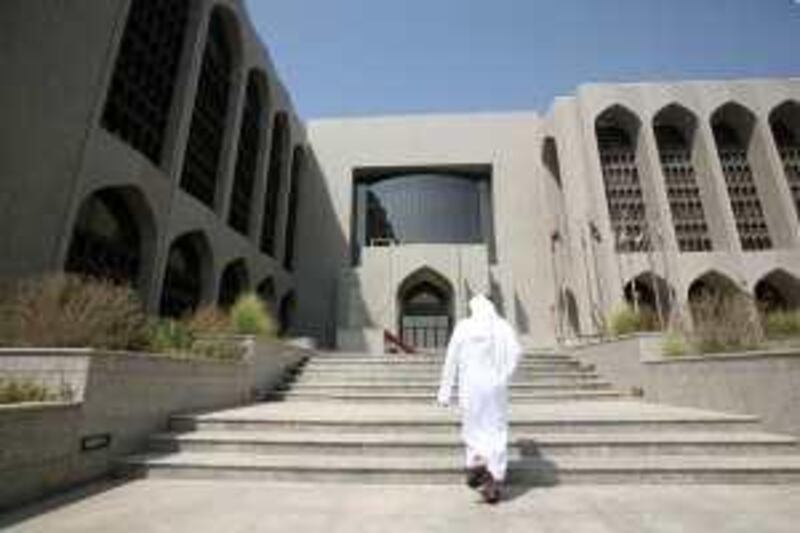The interbank offered rate in the UAE remains stubbornly high. The Central Bank believes the solution to a lower Eibor is to change the way it is determined. Asa Fitch reports The Central Bank's recent decision to establish a new benchmark interbank interest rate is the latest salvo in an ongoing tussle between the regulator and the country's banks. The banks have an interest in keeping the nominal interbank lending rate - or the interest rate they charge each other for short-term loans - at a high level, even if actual market rates are lower. Why? Those interbank rates form the basis from which a lot of loan products are priced.
Most mortgages in the UAE come with variable interest rates based on the benchmark; the Emirates interbank offered rate (Eibor) plus 4 per cent, for example. It stands to reason that if Eibor stays high, banks will make more money because they can charge higher rates of interest. And there is no disputing that the benchmark has remained higher than other Gulf countries' interbank rates during the past few months.
The three-month Eibor stands at about 2.33 per cent, having dipped substantially after the announcement that the Central Bank was in talks with banks to establish a new benchmark rate. But that is still much higher than interbank rates in Saudi Arabia, where the three-month rate is about 0.65 per cent, and in Kuwait, where rates are 1.25 per cent. While banks might be pleased with the status quo, the fact that Eibor has remained stubbornly high has been a conundrum for the Central Bank. One of the key things the regulator did to stimulate the UAE's economy during the financial crisis was to inject billions of dirhams of cash into the interbank market in order to reactivate lending.
By giving banks the ability to borrow from the Central Bank at low rates, the idea was that they would be able to lend more money and charge less interest, getting consumers and businesses to borrow more and spend more on big purchases and big projects. That, hopefully, would translate into lower Eibor rates, more banking business conducted and more goods and services bought, the pillars of economic recovery.
By taking charge of Eibor, the Central Bank appears to be enforcing the reporting of actual market rates instead of leaving it to the banks, as has long been the practice. The Central Bank said as much in a statement last week. The purpose of the new benchmark, it said, was "to facilitate a process whereby the rates fixed are a fair representation of the prevailing market conditions". The implication, of course, is that the way rates are now set is not a fair representation of market conditions.
Eibor is set using a poll of 10 foreign and local banks in the UAE, including Abu Dhabi Commercial Bank, National Bank of Abu Dhabi, HSBC and Standard Chartered. The highest and lowest rates are discarded, and an average is taken of the remaining rates to come up with the benchmark. The Central Bank's new methodology may involve a sampling from more banks, or even a sampling of all the medium-sized and large banks in the country. It remains unclear exactly how it will make the calculation, but the regulator has said it planned to launch the new benchmark in about a month.
The bottom line: if the Central Bank has its way, Eibor will go down. That, according to bankers and analysts, is clear enough. Banks, in fact, have already started to respond to the Central Bank's move. Emirates NBD and Abu Dhabi Commercial Bank adjusted their rates downwards by 0.05 per cent last week, according to a Reuters report. National Bank of Abu Dhabi lowered its rates by between 0.15 per cent and 0.25 per cent.
Those adjustments have helped push Eibor lower over the past week. It dipped from 2.45 per cent on August 4, when the Central Bank made its announcement, to 2.3 per cent on Wednesday. That was a 6.1 per cent decline. This trend towards lower interbank rates should come as welcome news to both the Central Bank and consumers who have loans with interest rates based on Eibor. The Central Bank is looking for proof that its economic stimulus measures, including Dh120 billion (US$32.67bn) in loan facilities and deposits at banks, are working. A decline in Eibor would be strong evidence of that. And a potential side effect could be lower interest rates on loans, a change many bank customers would welcome.
The position of the banks, meanwhile, is a bit trickier. Many banks would probably be happy sticking with the current Eibor calculation as they try to firm up their balance sheets during a time of sharply lower profitability. Plenty of banks want to restrict loan growth and attract deposits in order to improve their loan-to-deposit ratios. But there is a danger that a lower Eibor could lead to stronger loan growth. The lower rates could also lead banks to lower the interest rates they offer on term deposits, hampering efforts to stoke deposit growth.
The wrangle over Eibor is a many-sided battle with complex consequences for consumers and banks. At least for now, the Central Bank appears to be winning. afitch@thenational.ae





